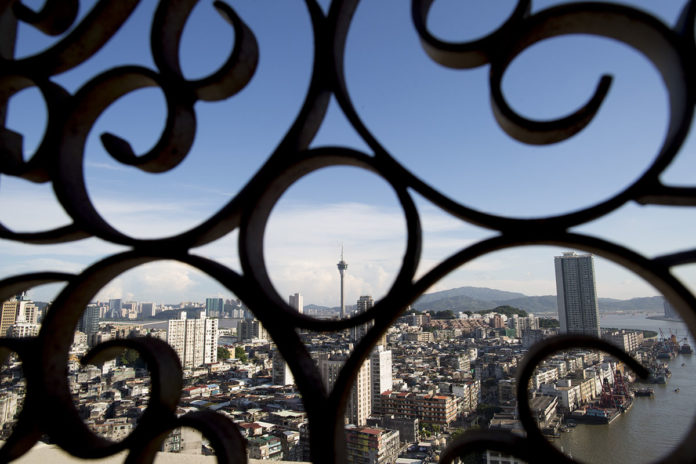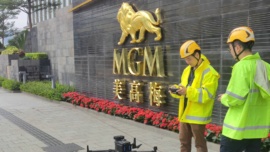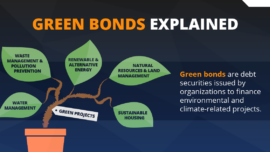The MSAR’s gross domestic product (GDP) is expected to undergo a 2.8 per cent year-on-year change this year, according to a report by the International Monetary Fund. Expectations are that growth will continue in 2018, with a 1.7 per cent year-on-year growth, notes the report.
The figures come after a 4 per cent year-on-year decrease in GDP last year, and reveal a slightly less optimistic outlook than that expressed in a 2017 macroeconomic forecast released in January of this year by the University of Macau’s Department of Economics.
The report predicted a 3.2 per cent year-on-year increase in GDP, hedged for figures between a ‘pessimistic forecast’ of a negative 6.9 per cent rate to ‘an optimistic rate’ of 13.2 per cent. The wide range was noted as being due to the fact that gross gaming revenues are ‘highly influenced by government policies and may adjust greatly throughout the year.’
Local economist and contributor to Business Daily, Albano Martins, noted that this year GDP could grow as much as 4.2 per cent, or sit within a range of “3.5 to 4.5 per cent,” noting that “forecasts will be an even more ‘artistic’ exercise in 2017” given the unpredictability of American politics under U.S. President Donald Trump.
While the Statistics and Census Service (DSEC) shows that real GDP, the measure also used by the IMF in its calculations, only fell 2.1 per cent year-on-year during 2016 and that nominal GDP (given that it is not adjusted for inflation) fell just 1.2 per cent year-on-year, the consensus – as well as that highlighted by the IMF – is a 4 per cent year-on-year reduction. The DSEC notes this is ‘mainly due to the weakening of total demand.’
For last year, the statistics authority notes that GDP reached MOP358.2 billion and that per capita GDP was MOP554,619.
Growth in real GDP predicted by the IMF for 2022 in the MSAR is expected to hit 3.8 per cent year-on-year, the highest yearly increase since 2013’s 11.2 per cent year-on-year increase, the year before the central government crackdown on corruption.
Consumer prices are also expected to increase this year and next year, with IMF predictions placing a 2.0 per cent year-on-year increase for this year, followed by a 2.2 per cent year-on-year increase in 2018.
Estimates for 2022 place consumer prices increase at 3.0 per cent year-on-year following a 2.4 per cent increase last year.
Global outlook
The turnaround in the economy experienced in the MSAR during the second half of the year, which the DSEC classified as a 5.7 per cent GDP ‘rebound’ compared to the previous year, was also experienced around the world, according to the IMF report.
Globally, the ‘economic upswing that we have expected for some time seems to be materialising,’ notes the IMF report, raising predictions from 3.4 per cent to 3.5 per cent for GDP increases this year compared to 2016. The forecast for 2018 ‘holds steady’ at a 3.6 per cent hike.
The group notes that the ‘expected’ growth improvements in this and next year ‘are broadly based, although growth remains tepid in many advanced economies, and commodity exporters continue to struggle.’
The IMF points out that ‘one salient threat’ is a rising ‘turn toward protectionism, leading to trade warfare’. This is prominent ‘mainly in advanced economies’ as evidenced by U.S. President Donald Trump’s ‘America First’ policy.
The trend has sprung up in the wake of ‘lower growth’ since the financial crisis of 2009 as well as ‘even slower growth of median incomes, and structural labour-market disruptions’ which the group notes as having ‘generated political support for zero-sum policy approaches that could undermine international trading relationships, along with multilateral co-operation more generally.’
However, a ‘notable surge in growth in the number of emerging markets and developing economies’ has been witnessed. Additionally, technological changes have contributed to ‘global trends in inequality’ related to trade; suggestions are for governments to ‘follow trade policies consistent with maximum productivity, supplementing those with other policies that better distribute the gains from foreign trade internally, improve the skills and adaptability of their workforces, and smooth the process of adjustment for those adversely affected by the need for economic reallocation.’
‘We could be at a turning point,’ notes the IMF, ‘but even as things look up, the post–World War II system of international economic relations is under severe strain despite the aggregate benefits it has delivered – and precisely because growth and the resulting economic adjustments have too often entailed unequal rewards and costs within countries.’
In order to handle the changing environment the authorities suggest that ‘policy must address these disparities head-on to ensure the stability of an open, collaborative trading system that benefits all.’
























